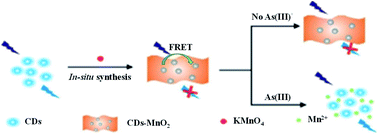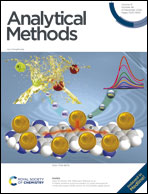Carbon dots–MnO2 nanocomposites for As(iii) detection in groundwater with high sensitivity and selectivity†
Abstract
As(III) pollution has caused increasing concern due to its significant impact in environmental safety and human health. Carbon dots (CDs)–MnO2 nanocomposites were prepared and characterized for As(III) detection. The intense blue fluorescence of CDs can be greatly quenched by functionalization with MnO2 nanosheets due to the existence of the fluorescence resonance energy transfer (FRET) effect. CDs–MnO2 nanocomposites were then used as a fluorescence sensor for As(III) detection with high detection sensitivity and selectivity. The redox reaction between As(III) and MnO2 nanosheets can induce the decomposition of MnO2 and termination of the FRET process. Then the blue fluorescence originating from CDs can be recovered. The detection limit of CDs–MnO2 nanocomposites toward As(III) was calculated to be 16.8 nM (1.40 ppb) in a linear concentration range of 0–200 nM. CDs–MnO2 nanocomposites were also found to possess highly selective ability toward As(III) detection. In addition, the spiked and recovery test also confirmed the practicality and reliability of CDs–MnO2 nanocomposites toward As(III) detection in real water samples, such as groundwater etc. Our research has provided a reliable tool and strategy for visual detection of As(III) with outstanding sensing ability.

- This article is part of the themed collection: Analytical Methods Recent HOT articles


 Please wait while we load your content...
Please wait while we load your content...